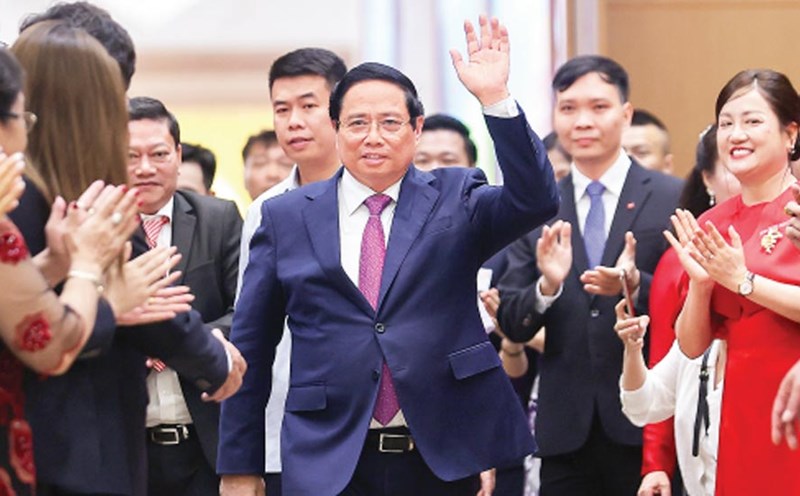Resolutely and flexibly managing monetary policy
From the beginning of 2025, the global economy continues to face many risks and uncertainties. tariffs, geopolitical tensions and unpredictable changes in monetary policy from major central banks have created significant challenges.
In that context, production and business activities in Vietnam continue to face difficulties. Consumption and export are affected by complex developments in the world economy and international financial markets.
Faced with this situation, our country has set an economic growth target of 8.3-8.5% for 2025, to create a solid foundation for the following years. deeply appreciating the importance of this task, the State Bank of Vietnam (SBV) affirmed that it will participate resolutely to work with the Government to realize the set goals.
According to the report of the State Bank, in the first 9 months of 2025, outstanding loans of the entire economy reached 17.46 million billion VND, an increase of 11.82% compared to the end of the previous year. System liquidity is guaranteed, operating interest rates continue to remain low, exchange rates are controlled within a reasonable range.
SBV Deputy Governor Pham Thanh Ha said that in 2025, SBV has proactively and promptly deployed synchronous management solutions to promote economic growth associated with maintaining macroeconomic stability, controlling inflation, and ensuring major balances of the economy. As a result, up to now, the liquidity of the credit institution system (CIs) has been guaranteed, the monetary market is stable, and exchange rates are flexible in accordance with market conditions.

Talking to reporters about the operator's efforts, Dr. Chau Dinh Linh, Ho Chi Minh City Banking University, assessed that the SBV's operations this year are both close to the goal of macro-stability and provide clear support for businesses.
He emphasized: " Monetary policy is aimed at three goals: financial stability, banking system safety and maintaining monetary stability. Since the beginning of 2025, the SBV has promoted credit growth since the beginning of the year by allocating clear targets and regulating them appropriately for each bank. Thanks to that, businesses have more opportunities to access capital for production and business activities. In addition, output interest rates are kept stable and tend to decrease slightly, helping to reduce interest costs, thereby improving net profits of enterprises".
Mr. Linh commented that the SBV has adjusted appropriately for each bank, avoiding capital accumulation in risky areas, while encouraging capital flow into production, export, high-tech agriculture and small and medium enterprises. Such a credit flow straightforward method helps capital flow to the right place, both supporting growth and controlling risks, he said.
Dr. Linh commented that the policy of extending debt and keeping the debt group maintained by the State Bank has become an important measure, not only reducing pressure on businesses but also preventing bad debt from increasing, contributing to stabilizing the system.
He also assessed that the SBV is working very vigorously to strengthen the banking system, requiring banks to supplement capital and comply with international standards such as Basel 2 and Basel 3. These moves help the banking system operate more safely and stably.
Regarding exchange rates, Dr. Linh said that most Vietnamese enterprises import raw materials for processing, processing and export. When the exchange rate is well controlled, the input cost of enterprises is maintained at a stable level, effectively supporting export activities. In the context of many fluctuations in the macro economy, the SBV has tried very hard to maintain this front, helping to control inflation and ensure affordable import capital for businesses.
Enterprises need to improve governance standards
According to Dr. Linh, although monetary policy is strongly supportive, businesses themselves still have to improve to take advantage of opportunities. He commented that in reality, many businesses have not separated capital flows, lacking clear and transparent business plans.
banking is a business unit, they only lend when they clearly see the ability to make a profit and the ability to repay the debt. Assets are only a secondary factor, the main thing is the business plan and financial transparency," said Mr. Linh.
He also recommended that businesses should not rely too much on bank loans. Increasing equity, issuing bonds or investment cooperatives is necessary to reduce risks. The relationship between banks and businesses must be a win-win relationship. The bank is not a issuer but a business partner. They can only accompany when they see common interests, he emphasized.
Finally, Dr. Chau Dinh Linh affirmed: Monetary policy management must always be flexible, adapting to fluctuations but on a stable macro-based platform. This is the key for Vietnamese enterprises to recover, stabilize and develop.
Indirect "push" helps Vietnam curb inflation
From a macro perspective, a positive signal has been pointed out by Dr. Chau Dinh Linh: the Fed's interest rate cut could become an indirect "push" to help Vietnam curb inflation. When import costs decrease, the input cost burden will be relieved, helping the consumer price index (CPI) " cool down" and remain stable. With the inflation target of 4.5% in 2025, the current outlook is still very bright. However, Dr. Linh also issued a warning: policy providers need to prepare flexible response scenarios, beware of the case of a sudden increase in domestic demand, causing the CPI to "exceeding the fence" and fluctuate unpredictably.










